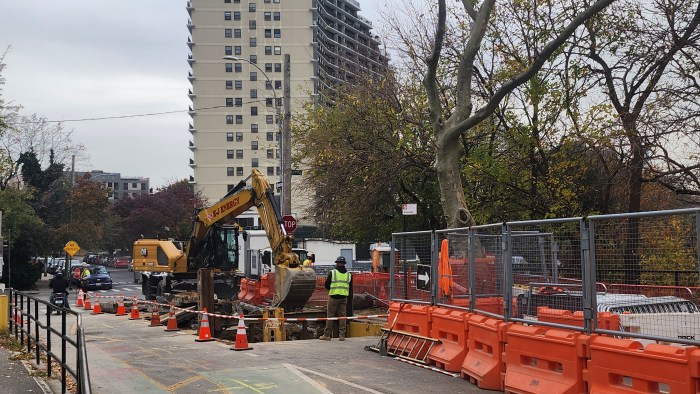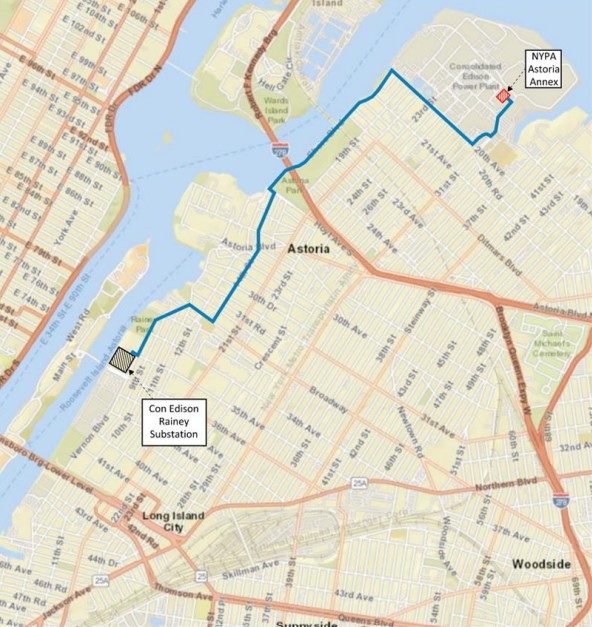
Construction work is underway along Shore Boulevard. Photo: Shane O’Brien
Nov. 21, 2024 By Shane O’Brien
Construction work for the Champlain-Hudson Power Express (CHPE) has started along Shore Boulevard in Astoria Park as part of the final stretch of a 339-mile underground transmission line that will bring clean energy from Canada to a converter station in Astoria by 2026.
Once completed, the transmission line will send hydropower from the U.S.-Canadian border to a new converter station near the Con Edison plants in northern Astoria. A cable will then link the CHPE to the Rainey Substation in Long Island City, located on the corner of 36th Avenue and Vernon Boulevard.
CHPE officials said the transmission line will supply around 20% of New York City’s power and decrease carbon emissions in the area by 37 million metric tons in the first 15 years of operation. The completed line will also reduce harmful local air pollutants by around 20% and create around 3,000 secondary jobs in New York City, CHPE officials said.
Laura Gibson, director for workplace development at CHPE, told a Community Board 1 meeting Tuesday that the transmission line is now over 50% complete, while work has now started in Astoria and Long Island City as part of the Astoria-Rainey Cable (ARC).
Workers began digging up a segment of Shore Boulevard at the south end of Astoria Park on Tuesday to dig trenches for the cable. A CHPE spokesperson said the work will last until April next year, stating that the roadway is currently closed to vehicular traffic.
“Shore Blvd is currently closed to vehicular traffic, with a lane maintained for use by emergency vehicles,” the spokesperson said. “Work will take place from November through April, and while phased sections of Shore Blvd will be closed to pedestrians and cyclists, pedestrians can still cross to access the waterfront. Cyclists may be routed onto the paved section of Shore Blvd to avoid construction areas.”
A CHPE official told CB1 Tuesday that CHPE spent “months” working with Astoria Park Alliance and NYC Parks to ensure that the work would not prevent local residents from accessing Astoria Park and Shore Boulevard.
Consequently, sidewalks on both sides of Shore Boulevard will remain open at all times throughout the construction phase, while an emergency lane will remain open at all times. The emergency lanes will be available to cyclists when it is not being used by emergency vehicles, a CHPE official said.
The CHPE official said CHPE has been communicating with local bike clubs about establishing alternative routes throughout the duration of the project, adding that CHPE is taking steps to ensure that pedestrians and cyclists can continue to safely use Shore Boulevard over the next five months.
The CHPE will remove no trees along Shore Boulevard throughout the five-month period and will only prune some trees along the route. Meanwhile, the entire length of Shore Boulevard within the boundaries of Astoria Park will be repaved and striped as part of the project.
Anthony Liberatoscioli, chair of the Astoria Park Alliance, said CHPE reached out to the alliance early in the planning stages of the Shore Boulevard project. Liberatoscioli praised CHPE for being receptive to the Alliance’s concerns and requests.
“We definitely wanted people to continue to be able to access the waterfront,” Libteratoscioli said. “The other big push that we wanted to make them aware of – and they were very receptive of – was to try to focus the timeline of the work to the winter months, when when the park is obviously less utilized.
“We appreciate that they have been very proactive to us about the timeline, that they have been good listeners and good partners about what the park needs, and that they’ve also been really interested in in supporting the park even beyond the scope of this project,” he added, noting that CHPE fully funded one of the movie nights in the park over the summer.
The Parks Department is also currently carrying out significant reconstruction of the Astoria Park Great Lawn Pathways. The project, which aims to reconstruct the landscape in Astoria Park north of the pool, began in September 2024 and is scheduled to be completed by December 2025, costing more than $6.3 million.
Meanwhile Gibson said CHPE will carry out door-to-door outreach before construction begins in different parts of the impacted areas to make local residents aware of the project. She also noted that CHPE has hosted several open houses in the neighborhood as well as communicating with businesses situated along the planned route.
The transmission line, which is being constructed by Transmission Developers, will deliver 1,250 megawatts of clean electricity, enough to power around one million homes. The line will deliver power from Canadian hydropower facilities owned by Hydro-Quebec.
E-J Electric Installation Co. is assisting with the ARC portion of the line through Long Island City and Astoria.

Photo: CHPE
The ARC will run from the new Astoria converter station, which is currently under construction, to the Rainey Substation in Long Island City. The buried 3.5 mile-long cable will run from the converter station to 20th Avenue, where it will turn west until it reaches Shore Boulevard. It will then run south through Astoria Park before merging onto 14th Street. The buried cable will turn west again on Broadway before making a final southward turn on Vernon Boulevard and reaching the Rainey Substation on the LIC waterfront.
Residents living on 14th Street raised concerns at Tuesday’s CB1 meeting, stating that 14th Street was a major north-south lane of traffic. One resident said closing the street could have major implications on traffic in the local area, particularly at rush hour, and asked that the road remain open during rush hour during construction of the ARC.
